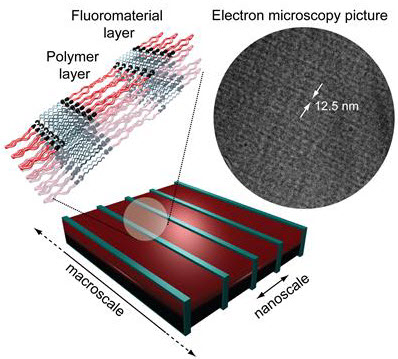New molecular self-assembly process scales up from nanometers to millimeters
June 10, 2014

Schematics and electron-microscope image of self-assembled polymeric nanostructure (credit: VTT Technical Research Centre of Finland)
Finnif
Finnish and Italian researchers have developed a way to align molecular self-assemblies from nanometers to millimeters, an alternative to conventional top-down lithography approaches for creating electronic devices.
Molecular self-assembly, a concept derived from biology, leads to spontaneous organization of molecules into more complex and functional supramolecular structures.
Molecular self-assembly has been used for “templating” (using a pattern to cut or shape) functional devices, molecular wires, memory elements, etc., but has typically required additional processing steps to achieve extended alignment of the structures. And typically, the structures lack common alignment and therefore the materials are disordered at macroscale (larger dimensions).

After heating to 38 and 47 °C, subsequent cooling and resting at room temperature for about 5 minutes results in a spherical crystalline domain (scale bars, 200 microns) (credit: VTT Technical Research Centre of Finland/Nature Communications)
The researchers at the Aalto University of Helsinki, the Politecnico di Milano, and VTT Technical Research Centre of Finland have now shown that by creating recognition elements between polymers and fluorinated small molecules, it’s possible to drive spontaneous self-assembly at macroscale (millimeters).
The research is described in Nature Communications June 4 (open access).
Abstract of Nature Communications paper
Aligning polymeric nanostructures up to macroscale in facile ways remains a challenge in materials science and technology. Here we show polymeric self-assemblies where nanoscale organization guides the macroscopic alignment up to millimetre scale. The concept is shown by halogen bonding mesogenic 1-iodoperfluoroalkanes to a star-shaped ethyleneglycol-based polymer, having chloride end-groups. The mesogens segregate and stack parallel into aligned domains. This leads to layers at ~10 nm periodicity. Combination of directionality of halogen bonding, mesogen parallel stacking and minimization of interfacial curvature translates into an overall alignment in bulk and films up to millimetre scale. Upon heating, novel supramolecular halogen-bonded polymeric liquid crystallinity is also shown. As many polymers present sites capable of receiving halogen bonding, we suggest generic potential of this strategy for aligning polymer self-assemblies.